Birds in the Piedmont region of the United States are diverse and abundant. The region is home to over 300 species of birds, including both migratory and resident species.
The Piedmont is an area of rolling hills and farmlands, providing an ideal habitat for a variety of species. From songbirds to raptors, there is an incredible range of birds to be found in the Piedmont.
Birders can enjoy a wide variety of birds throughout the year, from spring migrants to winter visitors. With its diverse habitats and abundant birdlife, Piedmont is a great place for birding..
1. Eastern Bluebird
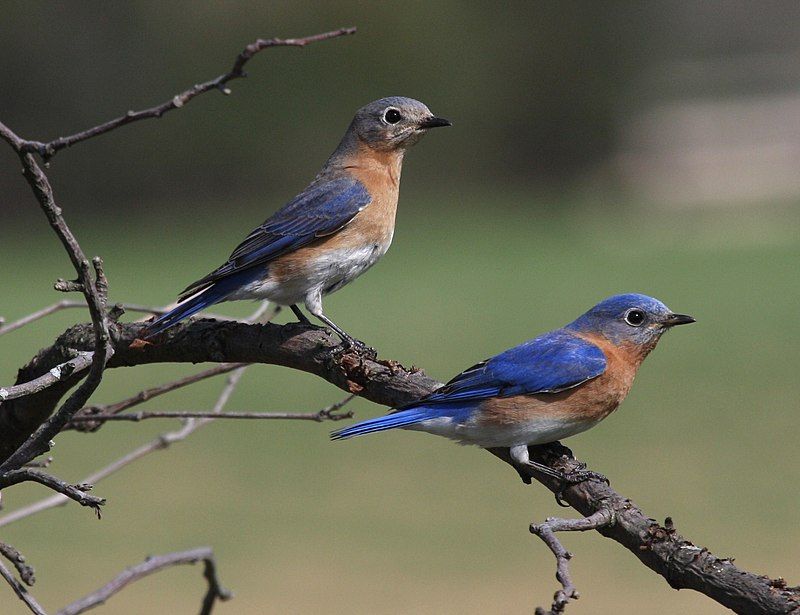
The Eastern Bluebird is a species of migratory thrush found in North America, ranging from open woodlands to farmlands and orchards. It is a small bird with a bright blue breeding plumage that is highly distinctive, making it a popular choice for birders.
The Eastern Bluebird is especially easy to spot, as it tends to perch on wide-open structures such as wires or treetops. This makes it an ideal bird to observe and admire from a distance.
The Eastern Bluebird is also an important species to the environment, as it helps to control the insect population of its habitat. Additionally, its beautiful feathers make it popular among bird enthusiasts, as well as those who appreciate its unique coloring and appearance.
| Kingdom | Animalia |
| Phylum | Chordata |
| Class | Aves |
| Order | Passeriformes |
| Family | Turdidae |
| Genus | Sialia |
| Species | S. sialis |
2. Blue Jay
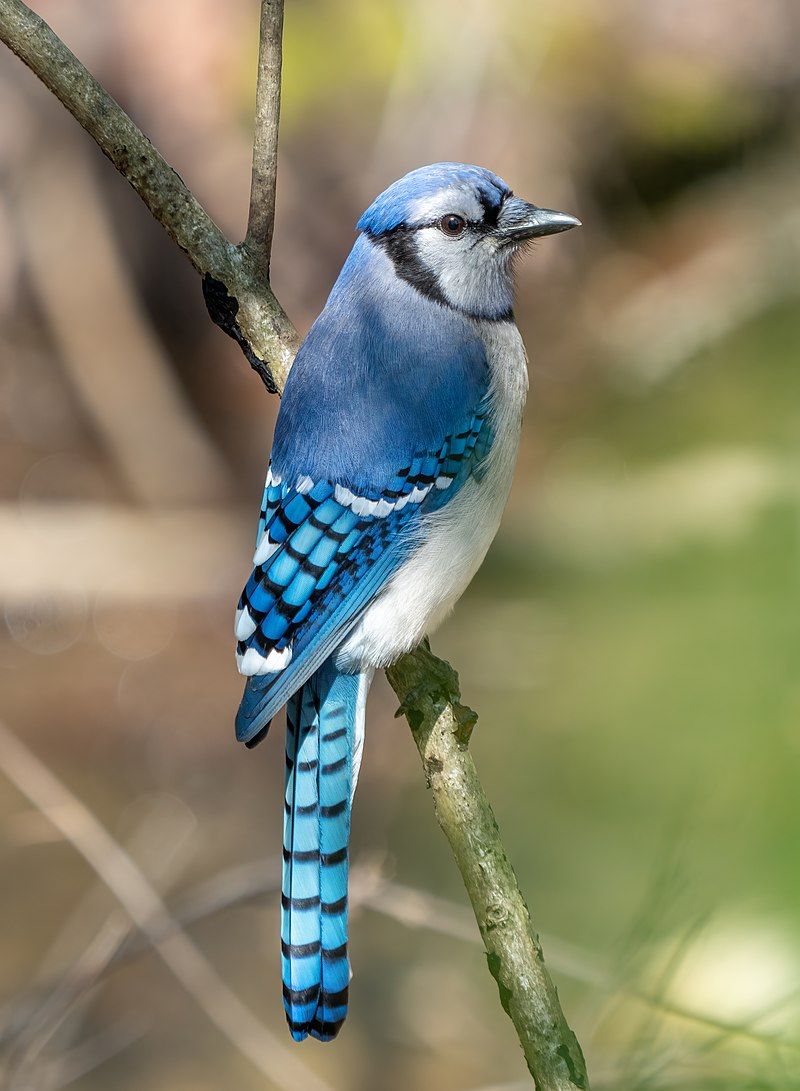
The blue jay is a type of bird belonging to the Corvidae family that is native to eastern North America. This species is mainly found in the eastern and central United States and some of the eastern populations may migrate seasonally.
Additionally, there are permanent resident populations of this species in Newfoundland, Canada, and breeding populations can be found across southern Canada. This bird species is recognized by its bright blue upperparts, white underparts, and a distinctive crest on its head.
The blue jay is also known for its loud and harsh vocalizations, which can be heard from a long distance. This species is an omnivorous bird that feeds on various items such as acorns, seeds, fruits, insects, and other small animals.
The blue jay is a very intelligent bird that is capable of understanding and solving complex problems. It is also a very social species, often forming large flocks and roosts during the winter months.
They are also known to be extremely territorial, defending their nests fiercely from potential predators. Overall, the blue jay is a beautiful and intelligent species that is native to eastern North America.
They are often seen in residential areas, parks, and wooded areas, making them an easily observed and appreciated bird.
| Kingdom | Animalia |
| Phylum | Chordata |
| Class | Aves |
| Order | Passeriformes |
| Family | Corvidae |
| Genus | Cyanocitta |
| Species | C. cristata |
3. Carolina Wren
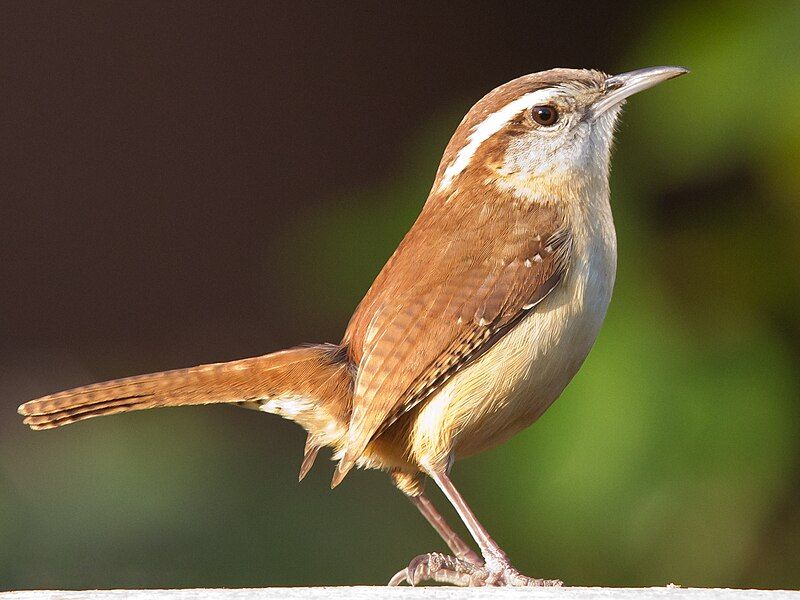
The Carolina wren is a species of wren found in a large area of North America. This wren species is a resident of the eastern half of the United States of America, the southernmost parts of Ontario, Canada, and the very northern tip of Mexico.
It is a common species, meaning that it can be seen frequently in its natural habitats. The Carolina wren is a small, plump bird with a rounded tail and a short, curved bill. The upper parts of the bird are typically dark gray, while the underparts are rich, reddish-brown.
The Carolina wren can be found in a wide variety of habitats, from deciduous woodlands to dense forests to suburban backyards. It is an active forager, often seen searching for insects and other small invertebrates in the leaf litter of the ground.
The Carolina wren is also known for being a very vocal bird, with a variety of songs and calls. This species is a great addition to any backyard or nature preserve, as it adds a splash of color and a lot of activity to its surroundings.
| Kingdom | Animalia |
| Phylum | Chordata |
| Class | Aves |
| Order | Passeriformes |
| Family | Troglodytidae |
| Genus | Thryothorus |
| Species | T. ludovicianus |
4. Northern Cardinal
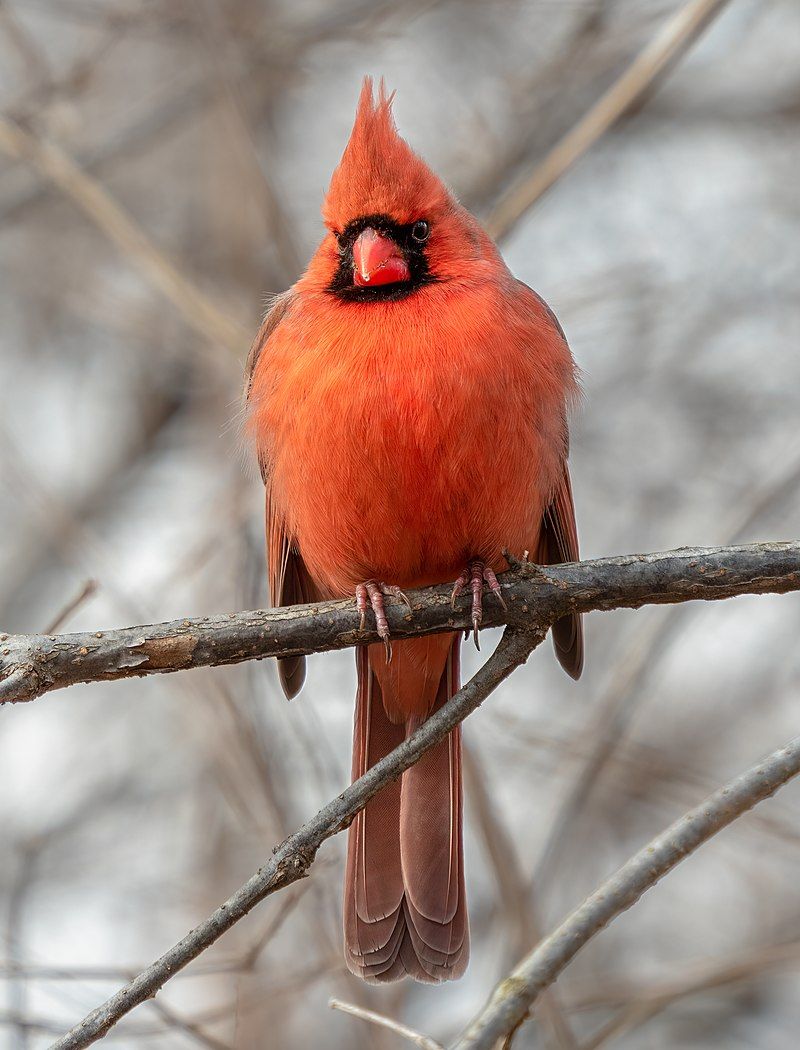
The northern cardinal, also known by its colloquial names such as redbird, common cardinal, red cardinal, or just cardinal, is a bird that belongs to the genus Cardinalis.
It is native to North America, and its bright red plumage has made it one of the most recognizable birds on the continent. The male bird is noted for its vibrant red color, while the female is a duller brown.
The northern cardinal is a social bird and usually lives in pairs or small groups. It feeds mainly on insects, fruits, and seeds, and it can be seen in gardens, woodlands, and other habitats.
Its loud and distinctive song is a familiar sound in many backyards, and its highly visible presence has made it a symbol of joy and good luck in many cultures.
| Kingdom | Animalia |
| Phylum | Chordata |
| Class | Aves |
| Order | Passeriformes |
| Family | Cardinalidae |
| Genus | Cardinalis |
| Species | C. cardinalis |
5. Goldfinch
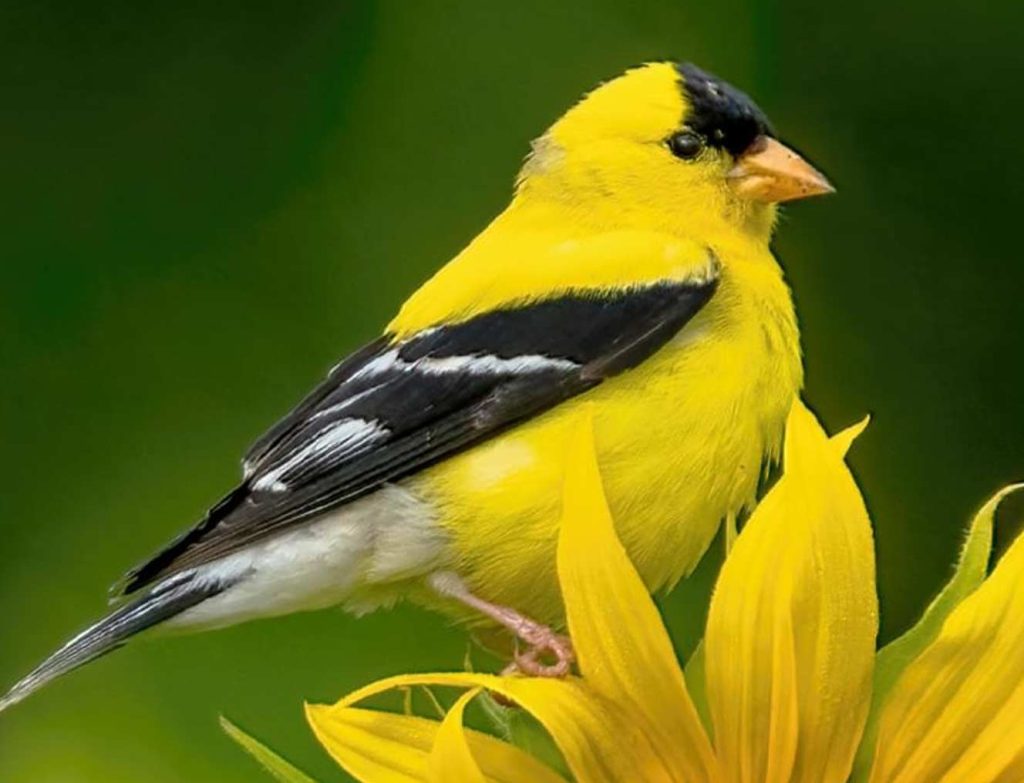
Source: allaboutbirds.org
The American goldfinch is a small, colorful bird that is found in the finch family. It is a migratory bird, meaning it moves from place to place depending on the season. During the breeding season, it can be found from mid-Alberta down to North Carolina.
In the winter, its range expands even further south, from just below the Canada-United States border all the way to Mexico. It is a very adaptable bird, able to find food and shelter in a variety of climates and habitats.
During the summer, it can be found in meadows, fields, and forests, while in the winter it prefers more open and sunny areas such as farmland, roadsides, and suburbs. It feeds mainly on seeds, which it can find in abundance in these areas.
The American goldfinch is an important part of the North American bird population, and its beauty and cheerful song make it a delight to observe.
| Kingdom | Animalia |
| Phylum | Chordata |
| Class | Aves |
| Order | Passeriformes |
| Family | Fringillidae |
| Genus | Spinus |
| Species | S. tristis |
6. Red-Winged Blackbird
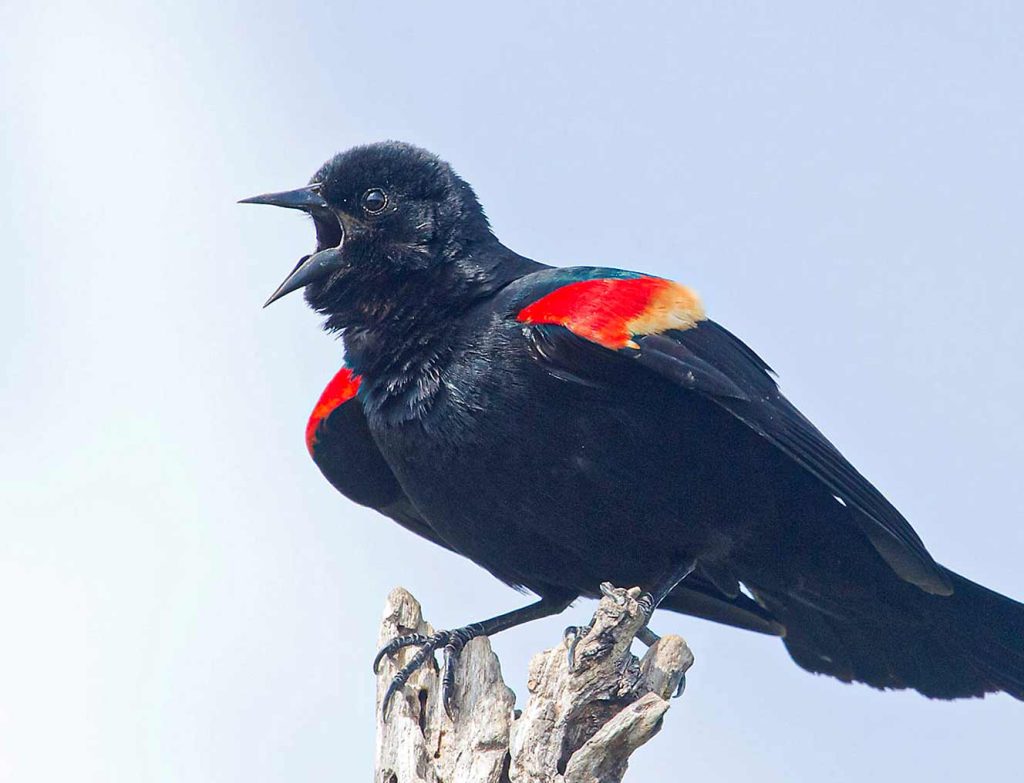
Source: vtecostudies.org
The Red-winged Blackbird is a species of bird belonging to the family Icteridae, which is a group of passerine birds native to North America and Central America. This species of blackbird is named for its distinctive red wing patches, which can be seen in flight.
The Red-winged Blackbird is a medium-sized species, with an adult male reaching lengths of around 24 cm. Its body is mainly black in color, with a yellow-orange epaulet on each shoulder and a yellow band running along the wings.
The Red-winged Blackbird is a highly abundant species and can be found in a variety of habitats, from open fields and marshes to urban parks and gardens. In the summer months, they are often seen in large flocks, foraging for seeds and insects.
They are also a popular species for birdwatchers, as they are relatively easy to spot and identify. The Red-winged Blackbird is an important part of the North American ecosystem, providing food for many other species as well as controlling insect populations.
It is also an important species for commercial farmers, as it feeds on crop-damaging insects.
| Kingdom | Animalia |
| Phylum | Chordata |
| Class | Aves |
| Order | Passeriformes |
| Family | Icteridae |
| Genus | Agelaius |
| Species | A. phoeniceus |
7. House Finch
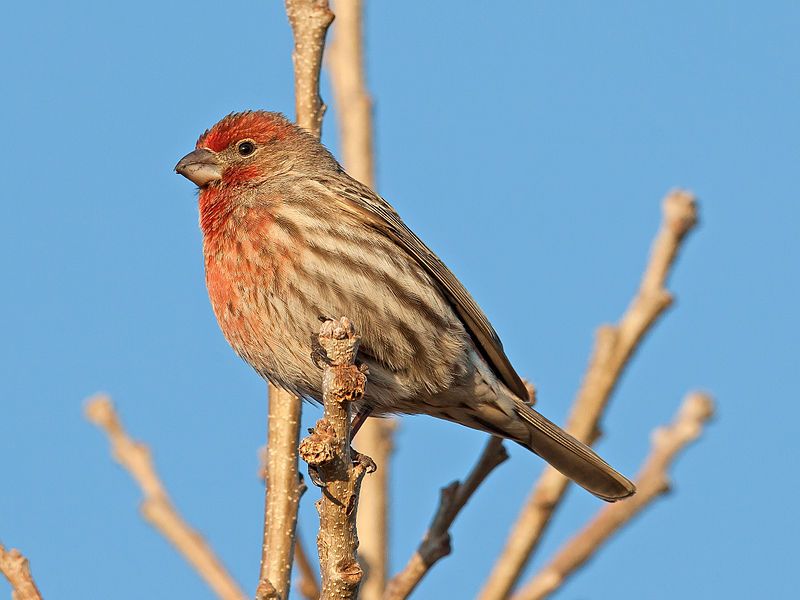
The house finch is a species of finch that is part of the Fringillidae family. It is native to the western part of North America, but it has been introduced to the eastern half of the continent and Hawaii.
The house finch belongs to the genus Haemorhous, which also includes two other species of American rosefinches. This species is highly adaptable and can be found in a variety of habitats, from urban areas to forests.
It is a small bird that is usually brown, grey, or reddish in color, with a short, conical beak. House finches are known for their cheerful songs and can often be seen in flocks, foraging for seeds and berries.
They have become quite popular with birdwatchers all over the world.
| Kingdom | Animalia |
| Phylum | Chordata |
| Class | Aves |
| Order | Passeriformes |
| Family | Fringillidae |
| Genus | Haemorhous |
| Species | H. mexicanus |
8. Tufted Titmouse
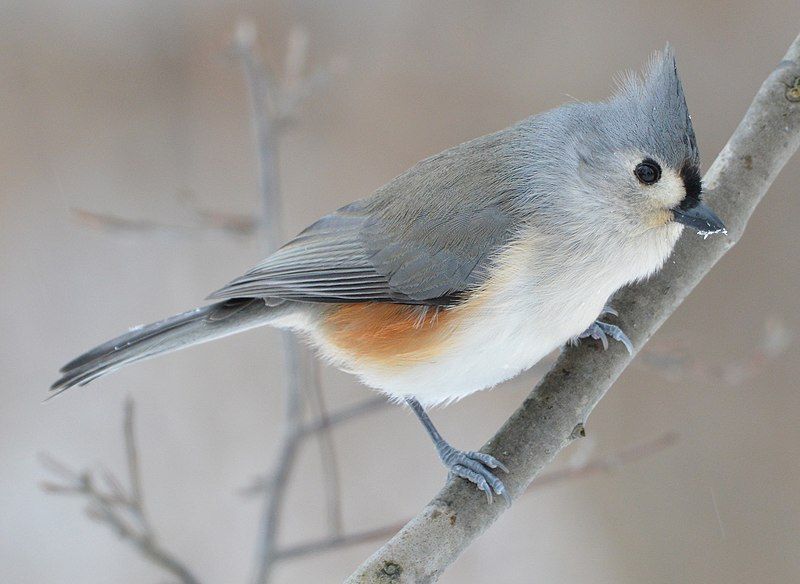
The tufted titmouse is a small songbird native to North America. It is a member of the tit and chickadee family, which includes a variety of species of birds.
The tufted titmouse is found in many parts of the United States and Canada and is well known for its distinctive black crest. The black-crested titmouse is a subspecies of the tufted titmouse, found in Central and Southern Texas.
It is now considered a separate species, Baeolophus atricristatus. The black-crested titmouse has a distinctive black crest and is found in Texas, Mexico, and parts of Central and South America.
It is an important species in its local ecosystems and is a valuable part of the bird diversity in this region. The tufted titmouse and the black-crested titmouse have many similarities, but they are separate species.
They are both small songbirds, but the tufted titmouse is found in a much larger area than the black-crested titmouse. The tufted titmouse is also much more common than the black-crested titmouse, making it an important species to conserve and protect.
It is important to recognize the differences between these two species and to ensure that they both continue to have healthy populations in their natural habitats.
| Kingdom | Animalia |
| Phylum | Chordata |
| Class | Aves |
| Order | Passeriformes |
| Family | Paridae |
| Genus | Baeolophus |
| Species | B. bicolor |
9. White-Breasted Nuthatch
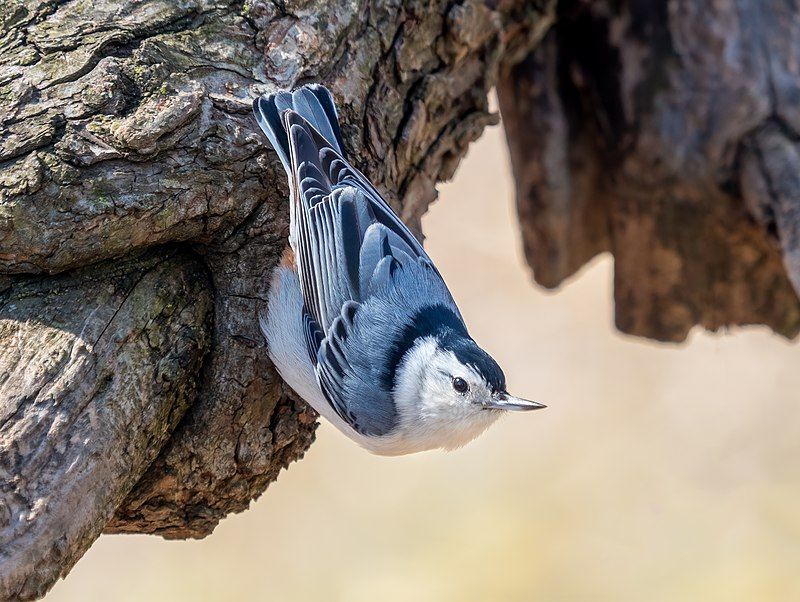
The white-breasted nuthatch is a species of bird belonging to the nuthatch family Sittidae. It is classified as a medium-sized nuthatch, measuring approximately 15.5 cm in length.
This species of bird has a unique appearance, with a white breast, grey back, and black crown that distinguishes it from other nuthatches. Its beak is long and pointed, and its tail is slightly curved.
The nuthatch is an acrobatic species, able to climb up and down trees quickly and easily. It feeds mainly on insects and spiders, and can often be found perched at the top of trees, where it is better able to search for food.
The white-breasted nuthatch is a sociable bird, and can often be seen in pairs or small groups. They are also known to communicate with each other using a variety of calls and songs. As a result, they are a popular species among birdwatchers.
| Kingdom | Animalia |
| Phylum | Chordata |
| Class | Aves |
| Order | Passeriformes |
| Family | Sittidae |
| Genus | Sitta |
| Species | S. carolinensis |
10. White-Crowned Sparrow
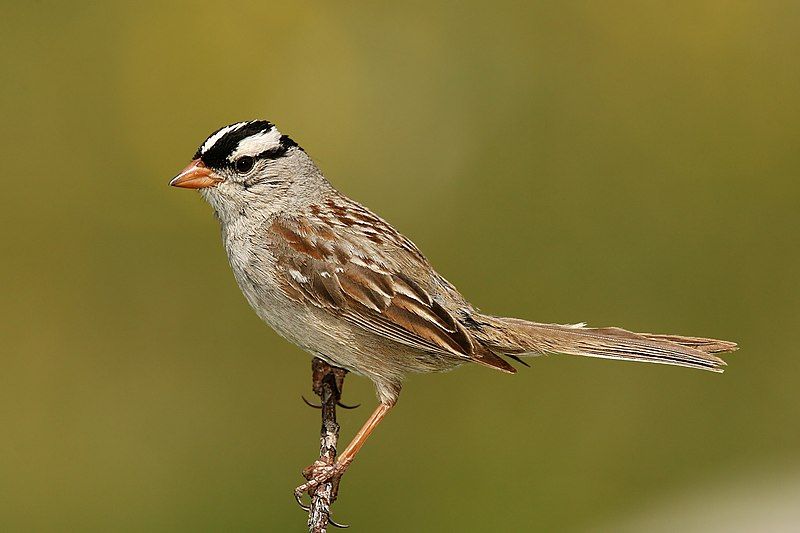
The white-crowned sparrow is a species of bird that is native to North America. It belongs to the New World sparrow family and is of medium size. The most distinctive features of the white-crowned sparrow are its grey face and streaked black and white upper head.
The white-crowned sparrow is a common sight in the open fields and grasslands of North America. It has a wide range of habitats, including deserts, forests, brush, and shrublands. The white-crowned sparrow is a social bird that is often seen in flocks.
It feeds on insects, seeds, and berries. During the breeding season, the white-crowned sparrow builds a cup-shaped nest in trees or shrubs and lays two to six eggs.
The male and female both take part in the nesting and care of the young. The white-crowned sparrow is a species that is well-adapted to life in North America. Its colorful markings and cheerful song make it a welcome addition to any bird-watching outing.
This species has a conservation status of least concern, meaning it is not in danger of extinction. Overall, the white-crowned sparrow is a beautiful and interesting bird that adds to the beauty and diversity of North America.
| Kingdom | Animalia |
| Phylum | Chordata |
| Class | Aves |
| Order | Passeriformes |
| Family | Passerellidae |
| Genus | Zonotrichia |
| Species | Z. leucophrys |
11. Song Sparrow
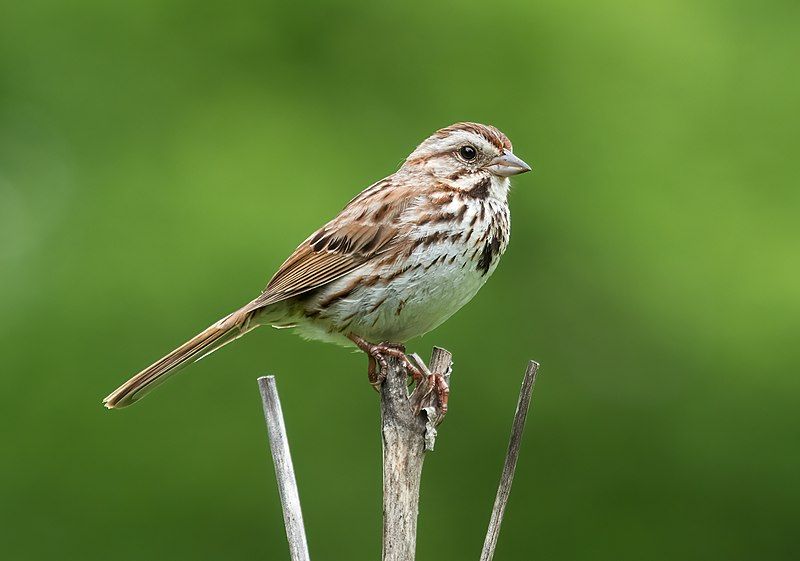
The song sparrow is a type of sparrow that is native to North America. It is medium-sized compared to other sparrow species. It is also one of the most abundant species of sparrow in the region.
This is due to its adaptability and variability in its habitat and living conditions. It can live in a variety of habitats, from forests to grasslands to urban areas. This has allowed it to thrive and become one of the most commonly seen birds in North America.
It has also adapted its behavior to live alongside humans, and can often be seen in parks and gardens even in urban areas. This adaptability and variability have allowed it to become so abundant, making it a familiar sight for bird watchers across the continent.
| Kingdom | Animalia |
| Phylum | Chordata |
| Class | Aves |
| Order | Passeriformes |
| Family | Passerellidae |
| Genus | Melospiza |
| Species | M. melodia |
12. Downy woodpecker
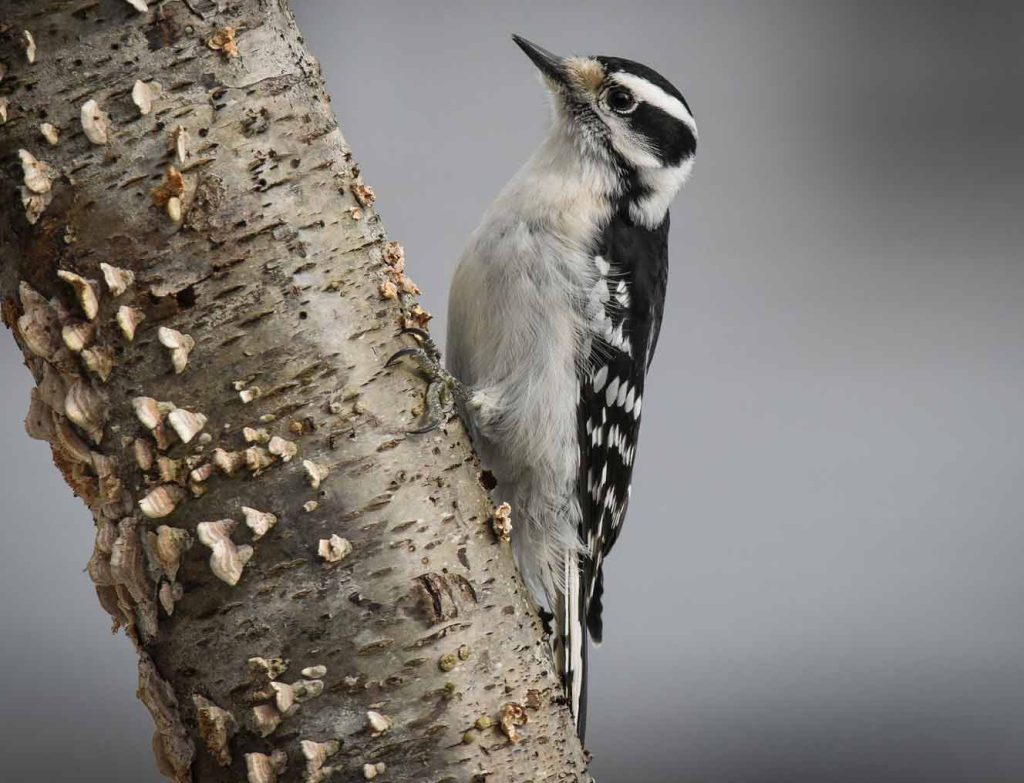
Source: ebird.org
The Downy Woodpecker is a species of woodpecker native to North America. It is the smallest in its class, with a length of between 14 and 18 centimeters.
This species is found in forests throughout the United States and Canada, with the exception of certain desert and tundra regions in the southwest and north. The Downy Woodpecker primarily feeds on insects found in tree bark, and will also eat fruits and nuts.
It is a common sight in wooded areas, and its distinctive call can be heard echoing through the trees. It is an important species in the North American ecosystem, helping to keep insect populations in check and providing food for other animals.
| Kingdom | Animalia |
| Phylum | Chordata |
| Class | Aves |
| Order | Piciformes |
| Family | Picidae |
| Genus | Dryobates |
| Species | D. pubescens |
13. Carolina Chickadee
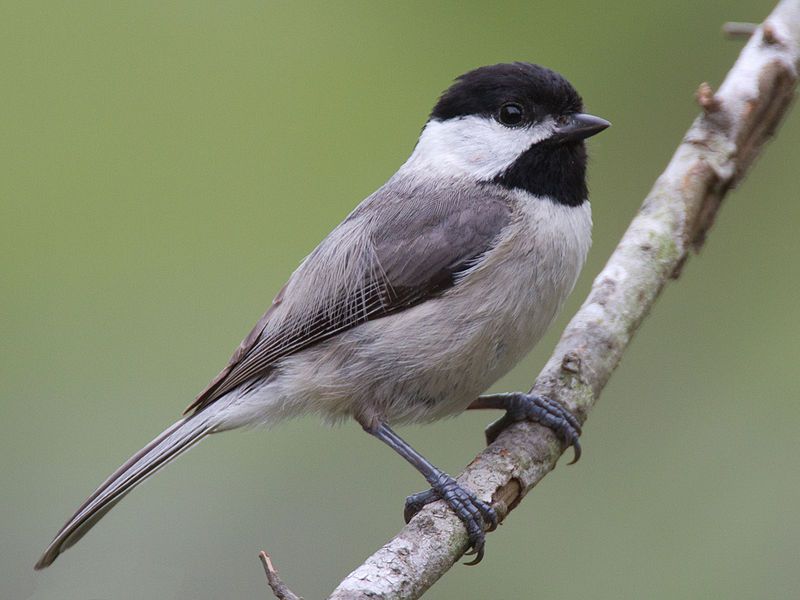
The Carolina chickadee is a small songbird belonging to the family Paridae, commonly known as the tit family. It is native to the southeastern United States and can be found in the states of North Carolina, South Carolina, Virginia, and Georgia.
The Carolina chickadee is a small bird, usually measuring between five and seven inches in length. Its plumage is grey and white, with a black cap and bib, and a white stripe above the eyes.
It has a distinctive call, consisting of two or three notes that sound like “chick-a-dee-dee”. The Carolina chickadee is found in a variety of habitats, including woodlands, wetlands, and parks. It feeds primarily on insects, but also eats small seeds and fruits.
The Carolina chickadee is a social bird and can often be seen in small flocks, foraging together for food. It is active year-round, and nests in cavities in trees or other structures.
The Carolina chickadee is an important part of the ecosystem, helping to control insect populations and dispersing seeds of native plants.
| Kingdom | Animalia |
| Phylum | Chordata |
| Class | Aves |
| Order | Passeriformes |
| Family | Paridae |
| Genus | Poecile |
| Species | P. carolinensis |
14. Chipping Sparrow
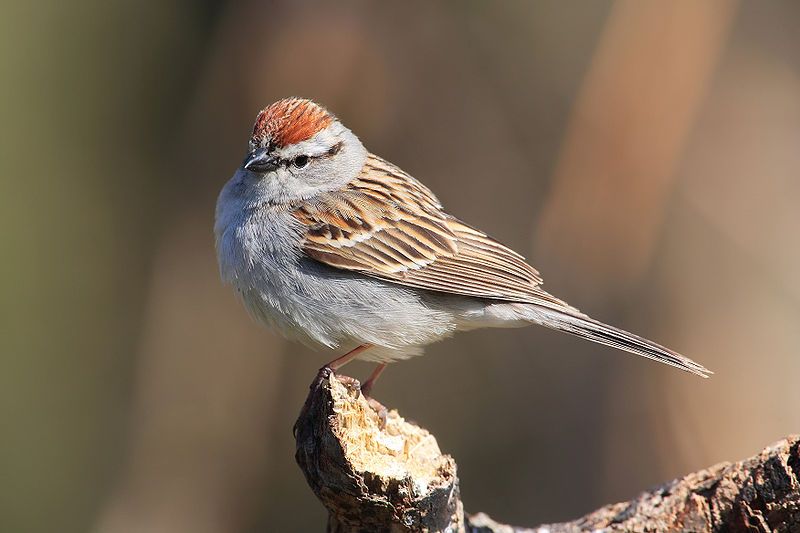
The chipping sparrow is a small passerine bird that is native to North America. It belongs to the family Passerellidae, which includes other species of New World sparrows. The chipping sparrow is a widespread species, found in most regions of North America.
It is also quite tame and common across most of its range. The chipping sparrow is divided into two subspecies: the eastern chipping sparrow and the western chipping sparrow.
The eastern chipping sparrow is found in the eastern regions of the United States, while the western chipping sparrow is found in the western regions.
Both of these subspecies have distinct physical characteristics that set them apart from each other, such as coloration and size. The chipping sparrow is a fairly small bird, typically measuring around 5 inches in length.
Its upperparts are a grayish-brown color, while its underparts are a lighter gray. It has a white eyebrow stripe and a black bib, making it easily recognizable.
The eastern chipping sparrow is usually slightly larger than the western chipping sparrow. The chipping sparrow is an adaptable species, often found in a variety of habitats. It can be found in urban areas, forest edges, grasslands, and even agricultural fields.
It feeds mainly on insects, but also eats some seeds and berries. The chipping sparrow is a fairly common species, and its populations appear to be stable.
It is not considered to be threatened at the moment, but its numbers could be affected by habitat loss and other human activities.
| Kingdom | Animalia |
| Phylum | Chordata |
| Class | Aves |
| Order | Passeriformes |
| Family | Passerellidae |
| Genus | Spizella |
| Species | S. passerina |
15. Brown-Headed Nuthatch
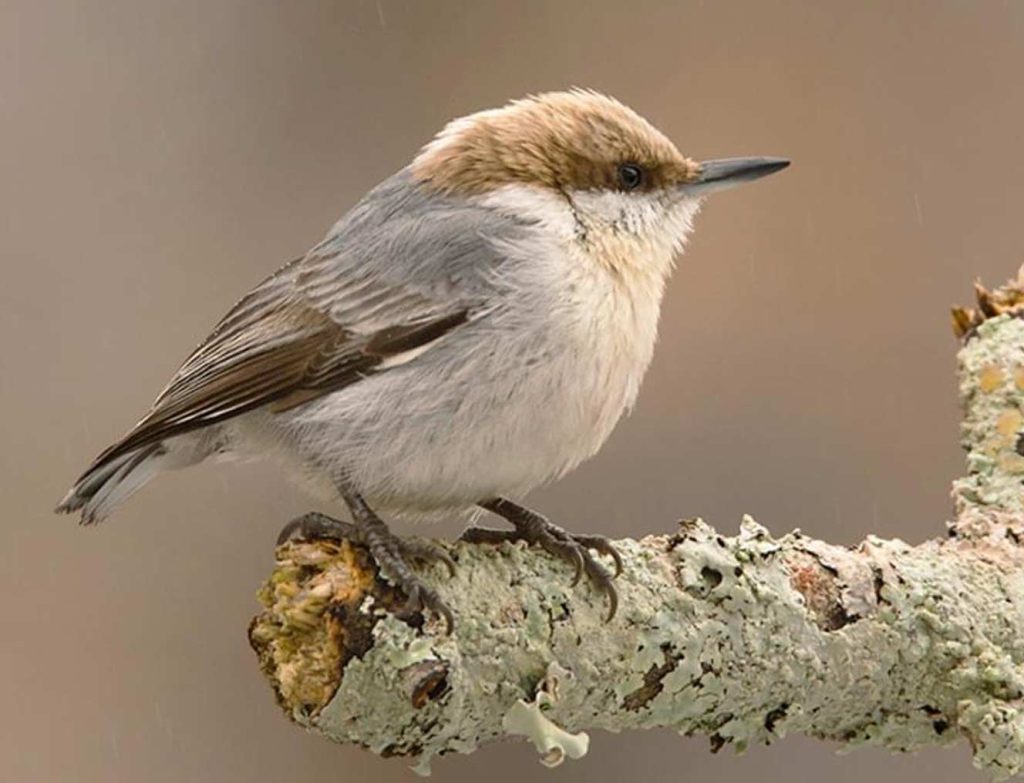
Source: allaboutbirds.org
The brown-headed nuthatch is a species of bird that is native to the pine forests of the Southeastern United States. It is a small songbird, measuring around 4 inches in length, with a brown head, grayish-brown back, and white underparts.
It has a white stripe above its black eyes and an orange-red patch on the back of its neck. The brown-headed nuthatch is an omnivorous bird, meaning it feeds on both plant and animal matter.
It can be found eating insects, spiders, and other arthropods, as well as acorns, pine seeds, and other vegetable matter. It has a distinctive call that is often heard in the spring and summer months.
The brown-headed nuthatch is an important species in its native habitat, helping to disperse the seeds of the pine trees and providing food for other animals in the forest.
It is currently listed as a species of least concern by the International Union for Conservation of Nature.
| Kingdom | Animalia |
| Phylum | Chordata |
| Class | Aves |
| Order | Passeriformes |
| Family | Sittidae |
| Genus | Sitta |
| Species | S. pusilla |
16. White-Throated Sparrow
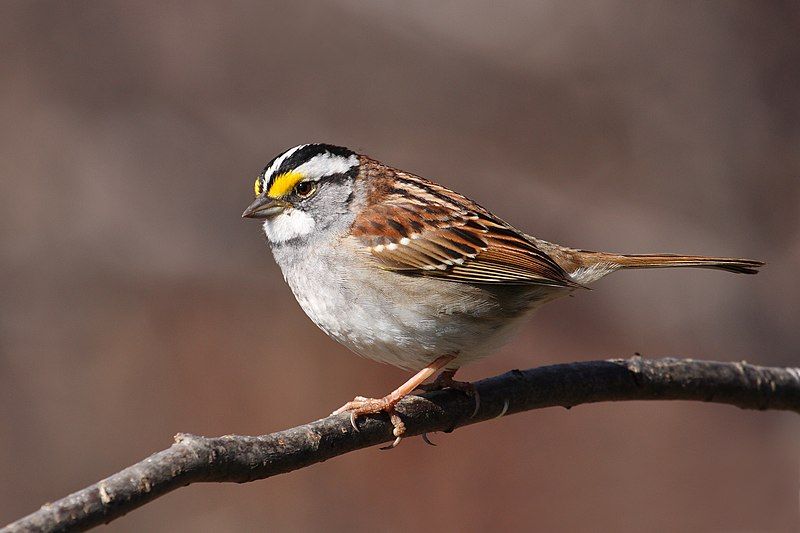
The white-throated sparrow is a species of bird that belongs to the passerine bird family, the Passerellidae. This family of birds is found in the New World, which includes North America, Central America, and South America.
These birds are quite small with a length of around five to six inches, and they are brown in color with a white throat and yellow patches around the eyes. They have a long tail and a conical beak which they use to feed on various seeds and insects.
As a passerine, the white-throated sparrow is able to fly and is often seen in open woodlands or even grasslands. They build their nests in shrubs or trees, and they are quite social creatures, often forming small flocks.
These birds are also quite vocal, and they have a distinctive song that is often heard during the breeding season. The white-throated sparrow is a common bird found throughout its range, and it is an important part of the native ecosystems.
| Kingdom | Animalia |
| Phylum | Chordata |
| Class | Aves |
| Order | Passeriformes |
| Family | Passerellidae |
| Genus | Zonotrichia |
| Species | Z. albicollis |
17. Wood Thrush
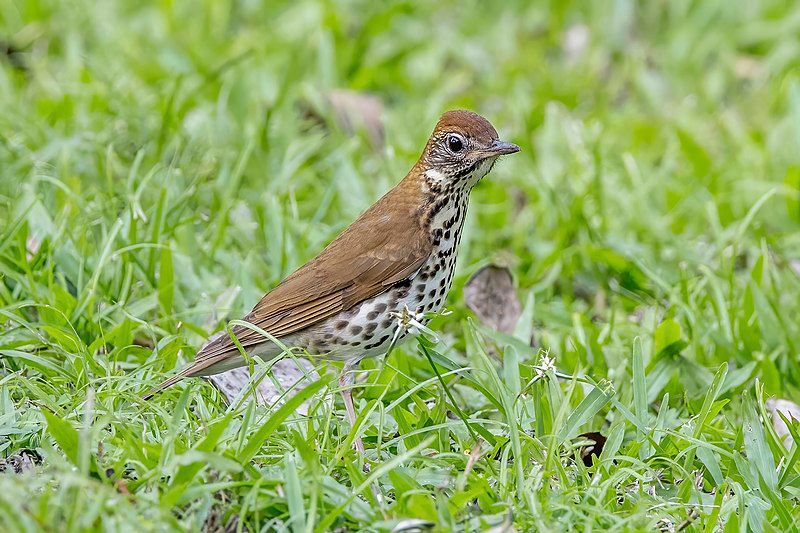
The wood thrush is a species of passerine bird that is native to North America. It is closely related to other birds in the thrush family, such as the American robin, and can be found in a wide variety of habitats across the continent.
During the winter months, the wood thrush migrates to Central America and southern Mexico. This species is so beloved that it has the honor of being the official bird of the District of Columbia.
In addition to its beauty, the wood thrush is a symbol of the region’s resilience and perseverance. Its distinctive song is a reminder of the importance of preserving and protecting its habitats so that future generations can experience the joy of hearing its sweet song.
| Kingdom | Animalia |
| Phylum | Chordata |
| Class | Aves |
| Order | Passeriformes |
| Family | Turdidae |
| Genus | Hylocichla |
| Species | H. mustelina |
18. Ruby-Throated Hummingbird
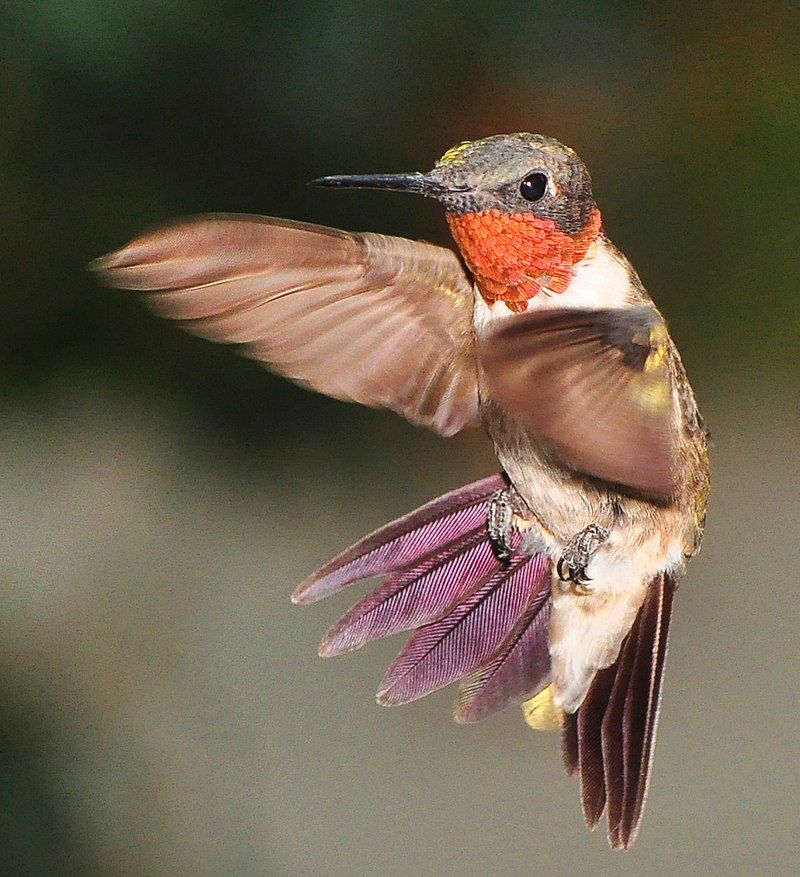
The ruby-throated hummingbird is a unique species of hummingbird that is known for its distinctive red throat. This species of hummingbird primarily resides in Central America, Mexico, and Florida during the colder months of the year.
As the seasons begin to change and summer approaches, the ruby-throated hummingbird embarks on an annual migration to Canada and other parts of Eastern North America in order to breed.
This annual migration is a long and difficult journey, however, the ruby-throated hummingbird is well-equipped to make the journey with its small size and lightweight body, allowing it to reach impressive speeds of up to 55 miles per hour.
Once the ruby-throated hummingbird arrives in its breeding grounds, it begins to build its nest and lay its eggs, providing the perfect environment for the young chicks to grow and thrive.
After the chicks have grown up, the ruby-throated hummingbird will then make its way south in order to spend the winter in the warmer climates of Central America and Mexico.
| Kingdom | Animalia |
| Phylum | Chordata |
| Class | Aves |
| Clade | Strisores |
| Order | Apodiformes |
| Family | Trochilidae |
| Genus | Archilochus |
| Species | A. colubris |
19. American Robin
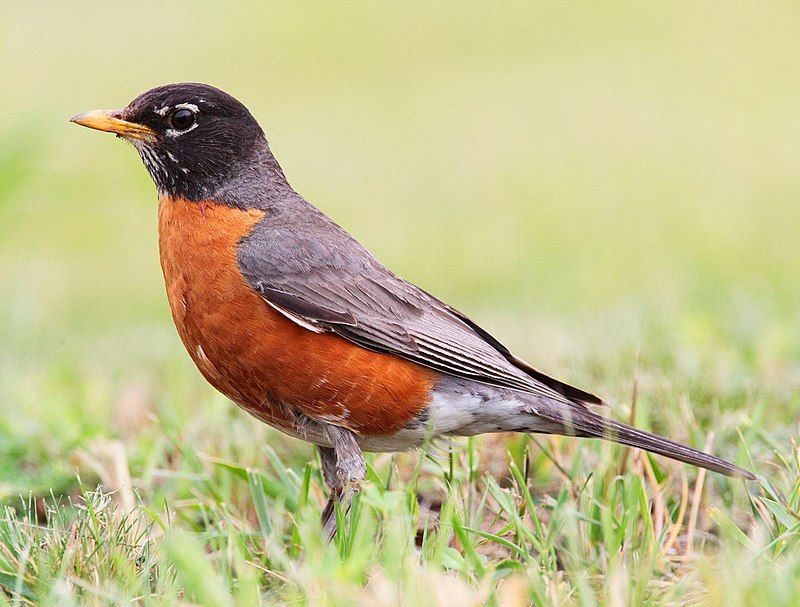
The American robin is a migratory bird that belongs to the true thrush genus and the larger thrush family, known as Turdidae.
This species of bird is named after the European robin due to its distinctive reddish-orange breast, even though the two birds are not very closely related. The European robin is actually part of the Old World flycatcher family.
The American robin is a widely recognizable bird in North America and is known for its early morning singing, which is usually heard during the dawn chorus.
This species of bird is typically seen in open woodlands, gardens, parks, and grasslands, and is often found near the edges of these areas. The American robin is also known for its diet, which mainly consists of earthworms, insects, and fruit.
| Kingdom | Animalia |
| Phylum | Chordata |
| Class | Aves |
| Order | Passeriformes |
| Family | Turdidae |
| Genus | Turdus |
| Species | T. migratorius |
20. Mourning Dove
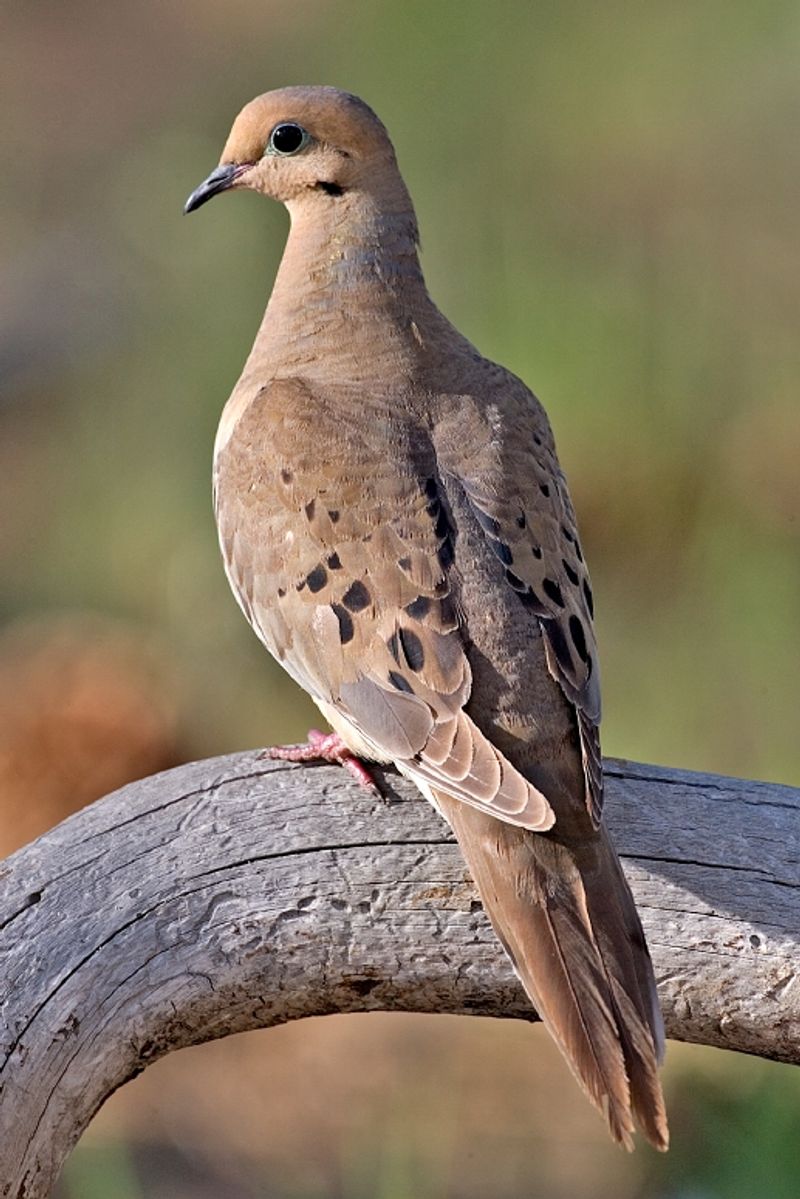
The mourning dove is a type of bird belonging to the Columbidae family. It is native to most of North America and is also known as the American mourning dove, the rain dove, and colloquially as the turtle dove.
Historically, it was known as the Carolina pigeon and Carolina turtledove. This bird is easily recognizable due to its distinctive call and its greyish-brown coloring. The mourning dove is also distinguished by its long tail and pointed wings.
The bird is mainly found in open woodland, grasslands, and farmlands, and it is often seen perching on power lines or fence posts. It is a ground-dwelling bird, and it feeds on a variety of seeds and grains.
The mourning dove is an important species in North America as it is a food source for many other animals, including larger birds of prey, and it is also hunted for sport.
| Kingdom | Animalia |
| Phylum | Chordata |
| Class | Aves |
| Order | Columbiformes |
| Family | Columbidae |
| Genus | Zenaida |
| Species | Z. macroura |
21. Eastern Towhee
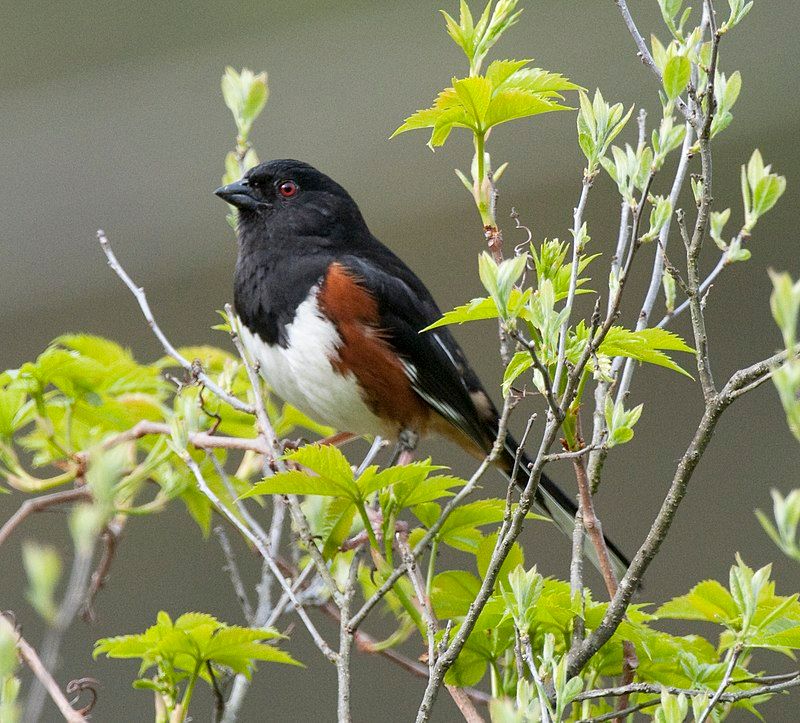
The eastern towhee is a large bird belonging to the New World sparrow family. It has been the topic of debate in recent decades due to its taxonomy. Historically, the eastern towhee and the spotted towhee were classified as one species, the rufous-sided towhee.
The eastern towhee’s natural habitat is dense shrubs and brushes across eastern North America, particularly during the breeding season. These birds are especially fond of dense thickets, as they provide them with protection from predators.
Eastern towhees are easily identifiable due to their distinctive features, including reddish-brown underparts, a white throat, chestnut flanks, and a black head, wings, and tail. These birds are also characterized by their loud and powerful songs.
During the breeding season, male eastern towhees often use these songs to attract female partners. The eastern towhee is an important species, as it plays a vital role in the food chain. It feeds on a variety of insects and seeds, which it obtains from foraging in the undergrowth.
It is also an important food source for other animals, such as foxes and hawks. The eastern towhee is an important species and its conservation is vital, as it is essential to the ecosystem.
To ensure the survival of this species, it is important to protect its habitats and provide it with the necessary resources. Additionally, it is important to raise awareness of the species and its importance to the environment.
| Kingdom | Animalia |
| Phylum | Chordata |
| Class | Aves |
| Order | Passeriformes |
| Family | Passerellidae |
| Genus | Pipilo |
| Species | P. erythrophthalmus |
22. Eastern Phoebe
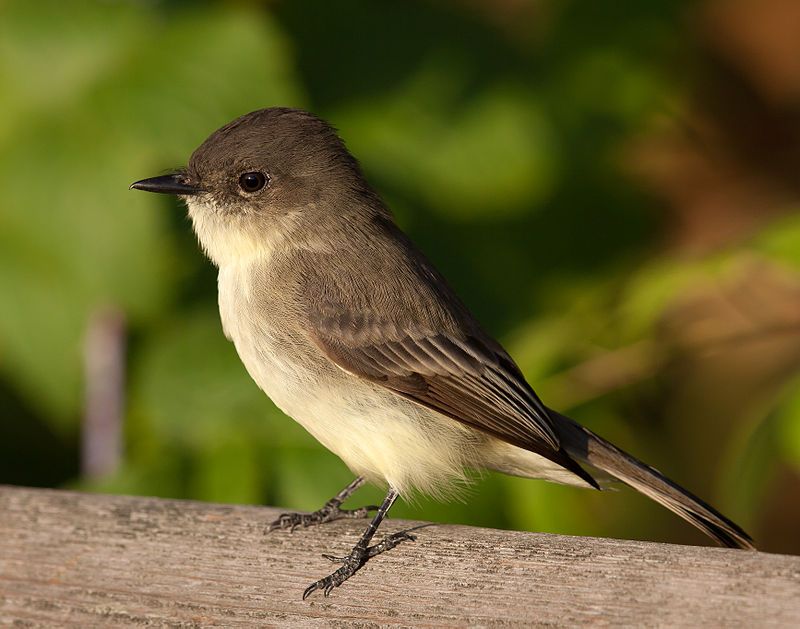
The eastern phoebe is a small bird belonging to the passerine family. These birds are scientifically classified under the genus Sayornis, which is derived from the specific part of Charles Lucien Bonaparte’s name for Say’s phoebe, Muscicapa saya.
The genus name also has a Greek origin, ornis, which translates to “bird”. This particular name was given to the bird species to distinguish it from other birds in the same family.
Charles Lucien Bonaparte was a French zoologist and ornithologist who specialized in the study of birds. He is best known for his work on the classification and scientific names of birds, and his description of Say’s phoebe was the first of its kind.
His name, in combination with the Ancient Greek ornis, was used to create the genus name Sayornis for the eastern phoebe. This genus name is still used today to refer to this species of bird.
In conclusion, the genus name Sayornis is derived from the specific part of Charles Lucien Bonaparte’s name for Say’s phoebe, Muscicapa saya, and Ancient Greek ornis, “bird”.
This name was given to the eastern phoebe to distinguish it from other birds in the same family and is still used to this day.
| Kingdom | Animalia |
| Phylum | Chordata |
| Class | Aves |
| Order | Passeriformes |
| Family | Tyrannidae |
| Genus | Sayornis |
| Species | S. phoebe |
23. Dark-Eyed Junco
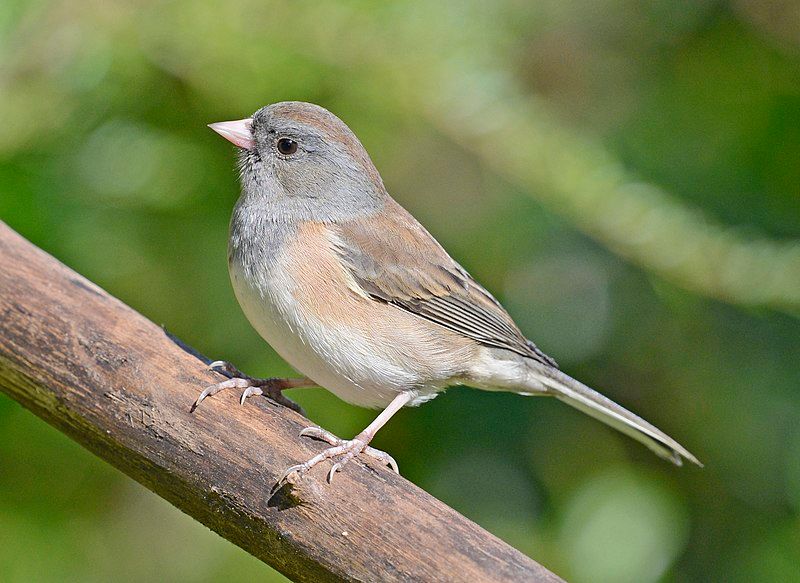
The dark-eyed junco is a species of junco, which is a group of small grayish sparrows found in the New World. It is a very common bird in temperate North America, and its range extends far into the Arctic during the summer.
This species is very variable, much like the fox sparrow, and scientists have not yet fully understood the complexities of its systematics. Its different forms have been divided into various subspecies, based on the geographical region in which they are found.
For example, the Slate-colored Junco, which is found primarily in the Appalachian mountains, is considered a subspecies of the Dark-eyed Junco. The Dark-eyed Junco is also known for its distinct coloring, with a black head and white belly, as well as its complex song.
| Kingdom | Animalia |
| Phylum | Chordata |
| Class | Aves |
| Order | Passeriformes |
| Family | Passerellidae |
| Genus | Junco |
| Species | J. hyemalis |
24. White-Winged Tern
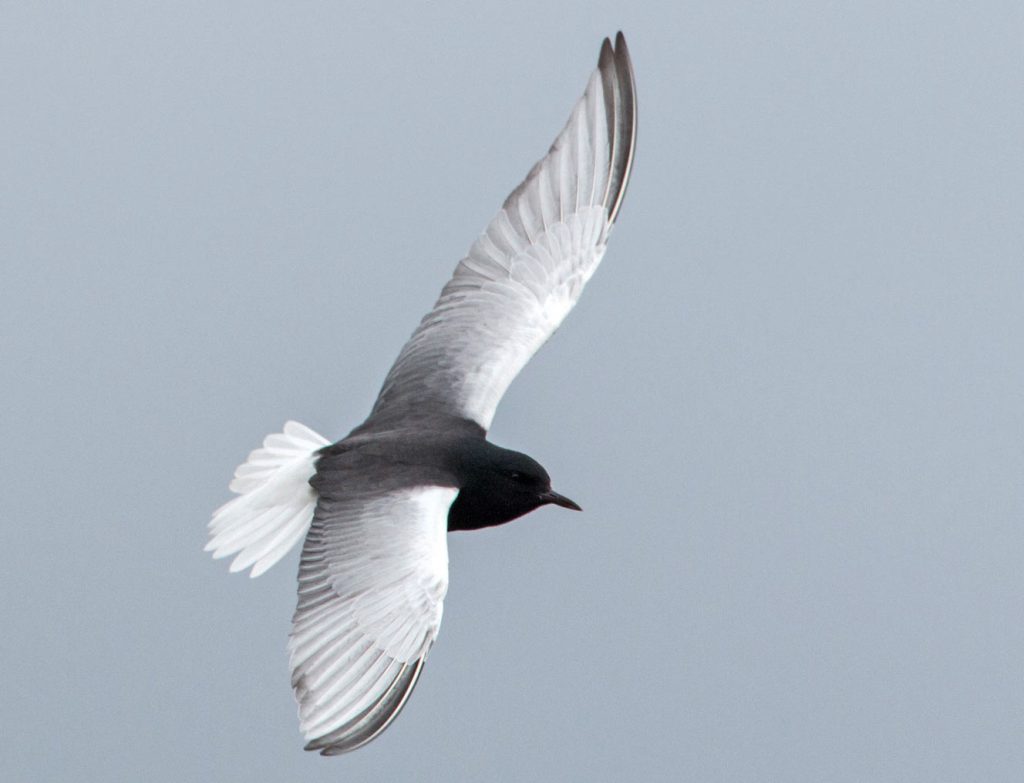
Source: ebird.org
The white-winged tern, or white-winged black tern, is a species of seabird in the family Laridae. It is a small, graceful species, usually found in or near bodies of fresh water, such as lakes and rivers.
The white-winged tern is considered a cosmopolitan species, meaning it can be found on most of the world’s continents, including Europe, Africa, Asia, and Australia. This species has a wingspan of around 20 inches and a body length of around 12 inches.
Its plumage is grey-black in color, with a white patch on the wings and a white tail. Its head is a darker shade of black than its body, and it has a black bill and yellow legs.
The white-winged tern is an adept flier, soaring over its habitat in search of small fish, insects, and amphibians. It is a migratory species, breeding during the summer months in temperate and subtropical regions, and then migrating south to warmer climates during the winter.
It is often found in large flocks, flying together in search of food. This species is listed as Least Concern by the IUCN, meaning it is not threatened with extinction.
| Kingdom | Animalia |
| Phylum | Chordata |
| Class | Aves |
| Order | Charadriiformes |
| Family | Laridae |
| Genus | Chlidonias |
| Species | C. leucopterus |
Conclusion
The birds of Piedmont provide a unique opportunity to observe the region’s diverse avian wildlife.
From the large raptors such as eagles that soar over the mountains to the smaller songbirds that make their homes in the rolling hills, the birds of Piedmont offer a variety of species to observe.
Whether it’s a snowy owl in the winter or a Baltimore oriole in the summer, Piedmont is a great place to observe birds in all seasons. With its varied habitats and abundance of bird species, the Piedmont region is a great place for bird-watching.